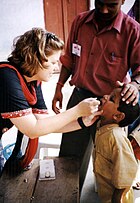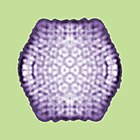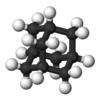Portal:Viruses
The Viruses Portal
Welcome!

Viruses are small infectious agents that can replicate only inside the living cells of an organism. Viruses infect all forms of life, including animals, plants, fungi, bacteria and archaea. They are found in almost every ecosystem on Earth and are the most abundant type of biological entity, with millions of different types, although only about 6,000 viruses have been described in detail. Some viruses cause disease in humans, and others are responsible for economically important diseases of livestock and crops.
Virus particles (known as virions) consist of genetic material, which can be either DNA or RNA, wrapped in a protein coat called the capsid; some viruses also have an outer lipid envelope. The capsid can take simple helical or icosahedral forms, or more complex structures. The average virus is about 1/100 the size of the average bacterium, and most are too small to be seen directly with an optical microscope.
The origins of viruses are unclear: some may have evolved from plasmids, others from bacteria. Viruses are sometimes considered to be a life form, because they carry genetic material, reproduce and evolve through natural selection. However they lack key characteristics (such as cell structure) that are generally considered necessary to count as life. Because they possess some but not all such qualities, viruses have been described as "organisms at the edge of life".
Selected disease
Rabies is a disease of humans and some other mammals, generally caused by the rabies virus, an RNA virus in the Rhabdoviridae family. A few cases have involved the closely related Australian bat lyssavirus. Rabies virus has a wide host range. Globally, dogs are the main source of human infections, with bats being important in the Americas; other naturally infected animals include monkeys, raccoons, foxes, skunks, cattle, horses, wolves, coyotes, cats, mongooses, bears, groundhogs, weasels and other carnivores. Transmission is commonly via saliva, usually but not always from bites; it can potentially occur via aerosols contacting mucous membranes. The typical human incubation period is 1–3 months. The neurotropic virus travels along neural pathways into the CNS and brain, where it causes meningoencephalitis. Nonspecific symptoms such as fever and headache are followed by neurological symptoms, including partial paralysis, confusion, agitation, paranoia, hallucinations and sometimes hydrophobia, which progress to delirium, coma and death. Around 17,400 people died from rabies in 2015, mainly in Asia and Africa.
Rabies is mentioned in the Codex of Eshnunna of around 1930 BC. The first vaccine was developed in 1885 by Louis Pasteur and Émile Roux. Prophylactic vaccination is used in people at high risk, pets and wild animals. Post-exposure prophylaxis, including vaccine and immunoglobulin, is completely effective if begun immediately after exposure, but survival is extremely rare once symptoms have begun.
Selected image
1802 cartoon of Edward Jenner administering cowpox vaccine against smallpox, satirising contemporary fears about vaccination.
Credit: James Gillray (12 June 1802)
In the news
26 February: In the ongoing pandemic of severe acute respiratory syndrome coronavirus 2 (SARS-CoV-2), more than 110 million confirmed cases, including 2.5 million deaths, have been documented globally since the outbreak began in December 2019. WHO
18 February: Seven asymptomatic cases of avian influenza A subtype H5N8, the first documented H5N8 cases in humans, are reported in Astrakhan Oblast, Russia, after more than 100,0000 hens died on a poultry farm in December. WHO
14 February: Seven cases of Ebola virus disease are reported in Gouécké, south-east Guinea. WHO
7 February: A case of Ebola virus disease is detected in North Kivu Province of the Democratic Republic of the Congo. WHO
4 February: An outbreak of Rift Valley fever is ongoing in Kenya, with 32 human cases, including 11 deaths, since the outbreak started in November. WHO
21 November: The US Food and Drug Administration (FDA) gives emergency-use authorisation to casirivimab/imdevimab, a combination monoclonal antibody (mAb) therapy for non-hospitalised people twelve years and over with mild-to-moderate COVID-19, after granting emergency-use authorisation to the single mAb bamlanivimab earlier in the month. FDA 1, 2
18 November: The outbreak of Ebola virus disease in Équateur Province, Democratic Republic of the Congo, which started in June, has been declared over; a total of 130 cases were recorded, with 55 deaths. UN
Selected article
Vaccination or immunisation is the administration of immunogenic material (a vaccine) to stimulate an individual's immune system to develop adaptive immunity to a virus or other pathogen, and so develop protection against an infectious disease. The active agent of a vaccine may be intact but inactivated or weakened forms of the pathogen, or purified highly immunogenic components, such as viral envelope proteins. Smallpox was the first disease for which a vaccine was produced, by Edward Jenner in 1796.
Vaccination is the most effective method of preventing infectious diseases and can also ameliorate the symptoms of infection. When a sufficiently high proportion of a population has been vaccinated, herd immunity results. Widespread immunity due to mass vaccination is largely responsible for the worldwide eradication of smallpox and the elimination of diseases such as polio from much of the world. Since their inception, vaccination efforts have met with objections on scientific, ethical, political, medical safety and religious grounds, and the World Health Organization considers vaccine hesitancy an important threat to global health.
Selected outbreak
The 1976 Zaire Ebola virus outbreak was one of the first two recorded outbreaks of the disease. The causative agent was identified as a novel virus, named for the region's Ebola River. The first identified case, in August, worked in the school in Yambuku, a small rural village in Mongala District, north Zaire. He had been treated for suspected malaria at the Yambuku Mission Hospital, which is now thought to have spread the virus by giving vitamin injections with inadequately sterilised needles, particularly to women attending prenatal clinics. Unsafe burial practices also spread the virus.
The outbreak was contained by quarantining local villages, sterilising medical equipment and providing protective clothing to medical personnel, and was over by early November. A total of 318 cases was recorded, of whom 280 died, an 88% case fatality rate. An earlier outbreak in June–November in Nzara, Sudan, was initially thought to be linked, but was shown to have been caused by a different species of Ebola virus.
Selected quotation
| “ | To help conceptualize the sheer number of viruses in existence, their current biomass has been estimated to equal that of 75 million blue whales (approximately 200 million tonnes) and, if placed end to end, the collective length of their virions would span 65 galaxies. | ” |
—Peter Simmonds
Recommended articles
Viruses & Subviral agents: bat virome • elephant endotheliotropic herpesvirus • HIV • introduction to viruses![]() • Playa de Oro virus • poliovirus • prion • rotavirus
• Playa de Oro virus • poliovirus • prion • rotavirus![]() • virus
• virus![]()
Diseases: colony collapse disorder • common cold • croup • dengue fever![]() • gastroenteritis • Guillain–Barré syndrome • hepatitis B • hepatitis C • hepatitis E • herpes simplex • HIV/AIDS • influenza
• gastroenteritis • Guillain–Barré syndrome • hepatitis B • hepatitis C • hepatitis E • herpes simplex • HIV/AIDS • influenza![]() • meningitis
• meningitis![]() • myxomatosis • polio
• myxomatosis • polio![]() • pneumonia • shingles • smallpox
• pneumonia • shingles • smallpox
Epidemiology & Interventions: 2007 Bernard Matthews H5N1 outbreak • Coalition for Epidemic Preparedness Innovations • Disease X • 2009 flu pandemic • HIV/AIDS in Malawi • polio vaccine • Spanish flu • West African Ebola virus epidemic
Virus–Host interactions: antibody • host • immune system![]() • parasitism • RNA interference
• parasitism • RNA interference![]()
Methodology: metagenomics
Social & Media: And the Band Played On • Contagion • "Flu Season" • Frank's Cock![]() • Race Against Time: Searching for Hope in AIDS-Ravaged Africa
• Race Against Time: Searching for Hope in AIDS-Ravaged Africa![]() • social history of viruses
• social history of viruses![]() • "Steve Burdick" • "The Time Is Now" • "What Lies Below"
• "Steve Burdick" • "The Time Is Now" • "What Lies Below"
People: Brownie Mary • Macfarlane Burnet![]() • Bobbi Campbell • Aniru Conteh • people with hepatitis C
• Bobbi Campbell • Aniru Conteh • people with hepatitis C![]() • HIV-positive people
• HIV-positive people![]() • Bette Korber • Henrietta Lacks • Linda Laubenstein • Barbara McClintock
• Bette Korber • Henrietta Lacks • Linda Laubenstein • Barbara McClintock![]() • poliomyelitis survivors
• poliomyelitis survivors![]() • Joseph Sonnabend • Eli Todd • Ryan White
• Joseph Sonnabend • Eli Todd • Ryan White![]()
Selected virus
Sputnik virophage is a subviral agent, discovered in 2008, that infects Acanthamoeba protozoa. It is a satellite virus of giant viruses of the Mimiviridae family. It requires a mimivirus to infect the cell simultaneously to replicate, hijacking the virus factories that mimivirus creates and impairing its replication. Sputnik was the first satellite to be shown to inhibit the replication of its associated helper virus. Such viruses have been termed "virophages" or "virus eaters" – by analogy with bacteriophages, viruses that parasitise bacteria – but the distinction between virophages and classical satellite viruses that infect plants, arthropods and mammals is disputed. Three Sputnik types are now known, and other virophages have since been discovered, now classified in the Lavidaviridae family, including the Zamilon, Mavirus and Organic Lake virophages. All virophages that have been characterised infect protists and all rely on nucleocytoplasmic large DNA viruses as helpers.
Sputnik's non-enveloped icosahedral capsid is 74 nm in diameter, and contains a circular double-stranded DNA genome of 18.3 kb. Three of its 21 predicted protein-coding genes are thought to derive from Acanthamoeba polyphaga mimivirus, suggesting that virophages and giant viruses can swap genes during their joint infection of Acanthamoeba, and also that virophages might mediate horizontal gene transfer between giant viruses.
Did you know?
- ...that derivatives of diamond-like compound adamantane (model pictured) are used as drugs against flu and Parkinson's disease?
- ...that for 36 years, only two polyomaviruses were known to infect humans?
- ...that Ali Maow Maalin was the last person in the world to be infected with naturally occurring smallpox?
- ...that in his 2005 book Race Against Time, the UN Special Envoy for HIV/AIDS in Africa Stephen Lewis claimed the spread of AIDS across Africa is partly due to a succession of disastrous economic policies promoted by international financial institutions?
- ...that his son's infection with polio in 1930 led electrical engineer Reinhold Rudenberg to develop an electron microscope as a tool to study the poliovirus?
Selected biography
Ali Maow Maalin (1954 – 22 July 2013) was a hospital cook and health worker from Merca, Somalia, who is the last person in the world known to be infected with naturally occurring smallpox. Although he worked in the local smallpox eradication programme, he had not been successfully vaccinated. In October 1977, he was infected with the Variola minor strain of the virus while driving two children with smallpox symptoms to quarantine. He did not experience complications and made a full recovery. An aggressive containment campaign was successful in preventing an outbreak, and smallpox was declared to have been eradicated globally by the World Health Organization (WHO) two years later.
In later life, Maalin volunteered for the successful poliomyelitis eradication campaign in Somalia. He worked for WHO as a local coordinator with responsibility for social mobilisation, and spent several years travelling across Somalia, vaccinating children and educating communities. He encouraged people to be vaccinated by sharing his experiences with smallpox. He died of malaria while carrying out polio vaccinations after the reintroduction of poliovirus to the country in 2013.
In this month
May 1955: First issue of Virology; first English-language journal dedicated to virology
4 May 1984: HTLV-III, later HIV, identified as the cause of AIDS by Robert Gallo and coworkers
5 May 1939: First electron micrographs of tobacco mosaic virus taken by Helmut Ruska and coworkers
5 May 1983: Structure of influenza neuraminidase solved by Jose Varghese, Graeme Laver and Peter Colman
8 May 1980: WHO announced formally the global eradication of smallpox
11 May 1978: SV40 sequenced by Walter Fiers and coworkers
12 May 1972: Gene for bacteriophage MS2 coat protein is sequenced by Walter Fiers and coworkers, the first gene to be completely sequenced
13 May 2011: Boceprevir approved for the treatment of chronic hepatitis C virus (HCV) infection, the first direct-acting antiviral for HCV
14 May 1796: Edward Jenner inoculated James Phipps (pictured) with cowpox
15/16 May 1969: Death of Robert Rayford, the earliest confirmed case of AIDS outside Africa
18 May 1998: First World AIDS Vaccine Day
20 May 1983: Isolation of the retrovirus LAV, later HIV, by Luc Montagnier, Françoise Barré-Sinoussi and coworkers
23 May 2011: Telaprevir approved for the treatment of chronic HCV infection
25 May 2011: WHO declared rinderpest eradicated
31 May 1937: First results in humans from the 17D vaccine for yellow fever published by Max Theiler and Hugh H. Smith
Selected intervention
| “ | the most damaging medical hoax of the last 100 years —Dennis Flaherty, 2011 |
” |
The MMR vaccine and autism fraud refers to the false claim that the combined vaccine for measles, mumps and rubella (MMR) might be associated with colitis and autism spectrum disorders. Multiple large epidemiological studies have since found no link between the vaccine and autism. The notion originated in a fraudulent research paper by Andrew Wakefield and co-authors, published in the prestigious medical journal The Lancet in 1998. Sunday Times journalist Brian Deer's investigations revealed that Wakefield had manipulated evidence and had multiple undeclared conflicts of interest. The paper was retracted in 2010, when the Lancet's editor-in-chief Richard Horton characterised it as "utterly false". Wakefield was found guilty of serious professional misconduct by the General Medical Council, and struck off the UK's Medical Register. The claims in Wakefield's article were widely reported in the press, resulting in a sharp drop in vaccination uptake in the UK and Ireland. A greatly increased incidence of measles and mumps followed, leading to deaths and serious permanent injuries.
Subcategories
Subcategories of virology:
Topics
Things to do
- Comment on what you like and dislike about this portal
- Join the Viruses WikiProject
- Tag articles on viruses and virology with the project banner by adding {{WikiProject Viruses}} to the talk page
- Assess unassessed articles against the project standards
- Create requested pages: red-linked viruses | red-linked virus genera
- Expand a virus stub into a full article, adding images, citations, references and taxoboxes, following the project guidelines
- Create a new article (or expand an old one 5-fold) and nominate it for the main page Did You Know? section
- Improve a B-class article and nominate it for Good Article
 or Featured Article
or Featured Article status
status - Suggest articles, pictures, interesting facts, events and news to be featured here on the portal
WikiProjects & Portals
 WikiProject Viruses
Related WikiProjects
WikiProject Viruses
Related WikiProjects
Medicine • Microbiology • Molecular & Cellular Biology • Veterinary Medicine
Related PortalsAssociated Wikimedia
The following Wikimedia Foundation sister projects provide more on this subject:
-
Commons
Free media repository -
Wikibooks
Free textbooks and manuals -
Wikidata
Free knowledge base -
Wikinews
Free-content news -
Wikiquote
Collection of quotations -
Wikisource
Free-content library -
Wikispecies
Directory of species -
Wikiversity
Free learning tools -
Wiktionary
Dictionary and thesaurus

















